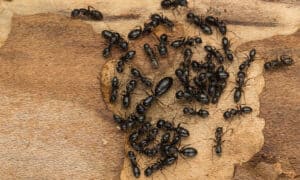Montana is home to a diverse array of ant species. In this article, we will explore the most common ants set to emerge in Montana, their habits, and the environmental factors that influence their behaviors. Each species has unique characteristics and behaviors, making them fascinating creatures.
So let’s embark on this entomological journey and discover the wonders of Montana’s ant kingdom.

Montana is home to many ant subspecies.
©Erik Agar/Shutterstock.com
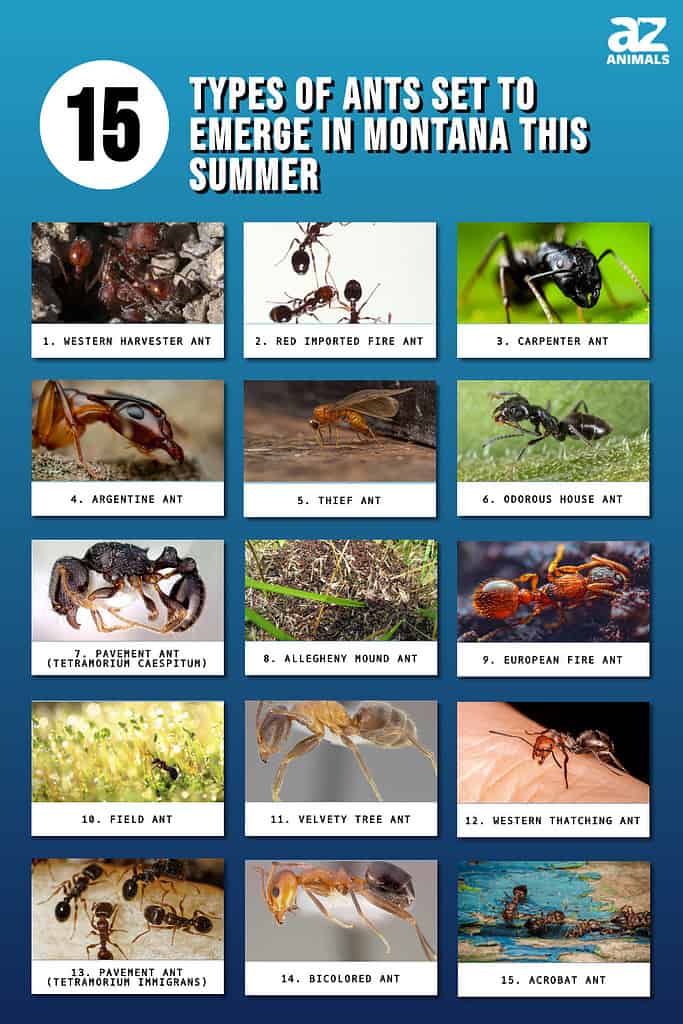
15 Types of Ants Found In Montana
1. Western Harvester Ant (Pogonomyrmex occidentalis)
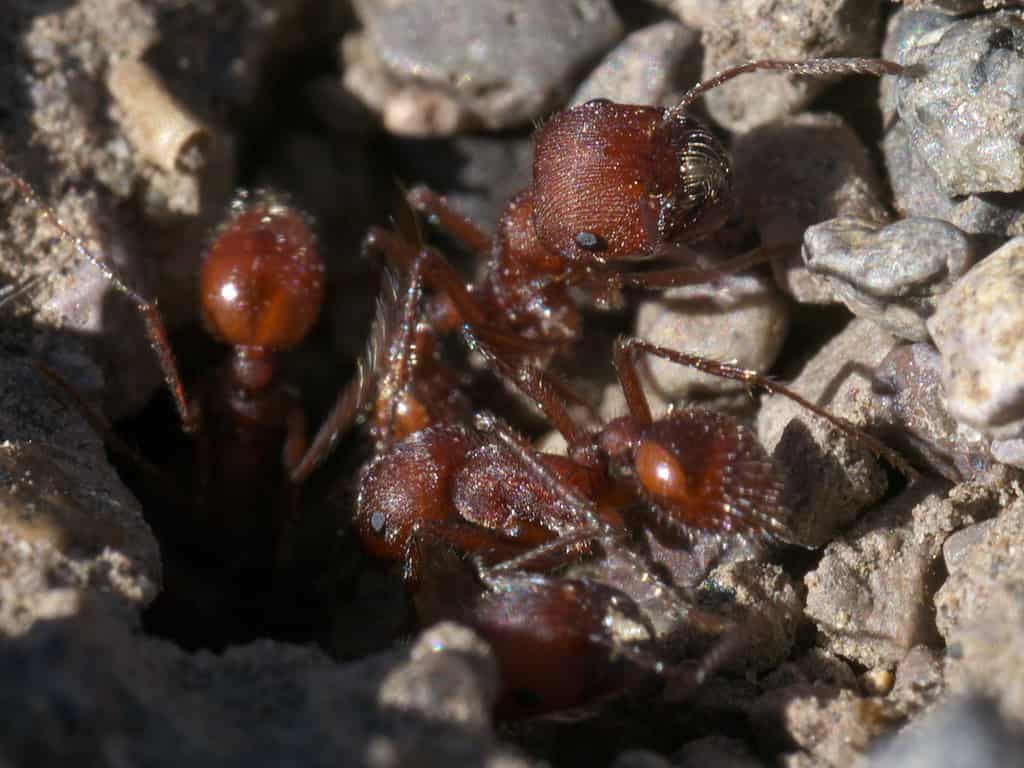
Western Harvester Ant (Pogonomyrmex occidentalis)
©xpda, CC BY-SA 4.0 – License
The Western Harvester Ant is one of the most abundant ants set to emerge in Montana. These medium-sized ants are known for their large, conical-shaped mounds and distinctive reddish-brown coloration. They are known to be highly efficient foragers and play a crucial role in maintaining the ecosystem’s balance.
2. Red Imported Fire Ant (Solenopsis invicta)
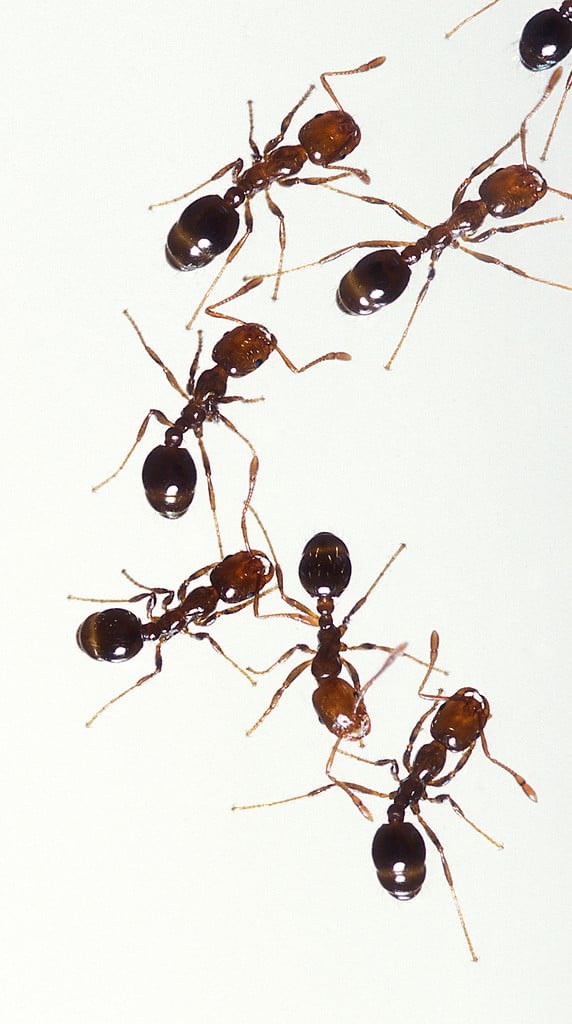
Red imported fire ants have a painful sting and swarming behavior that can harm humans and wildlife.
©Stephen Ausmus, Public domain – License
Among the ants set to emerge in Montana is the Red Imported Fire Ant. It is not native to Montana and has become invasive in some parts of the state. These aggressive ants are reddish-brown and build large, mound-shaped nests. Their painful sting and swarming behavior can harm humans and wildlife.
3. Carpenter Ant (Camponotus spp.)
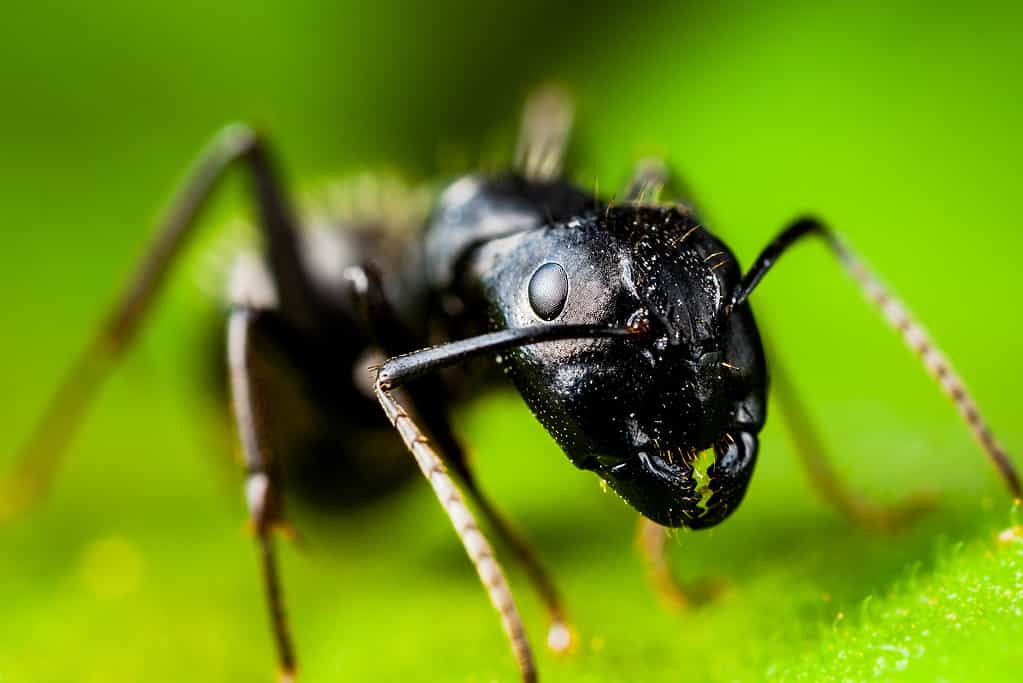
Carpenter ants don’t consume wood like termites but their presence can cause structural damage to homes and buildings.
©Denis Vesely/Shutterstock.com
Carpenter Ants are commonly found in forests and wooded areas throughout Montana. They are known for their impressive carpentry skills, excavating tunnels and galleries in wood. While they don’t consume wood like termites, their presence can cause structural damage to homes and buildings.
4. Argentine Ant (Linepithema humile)
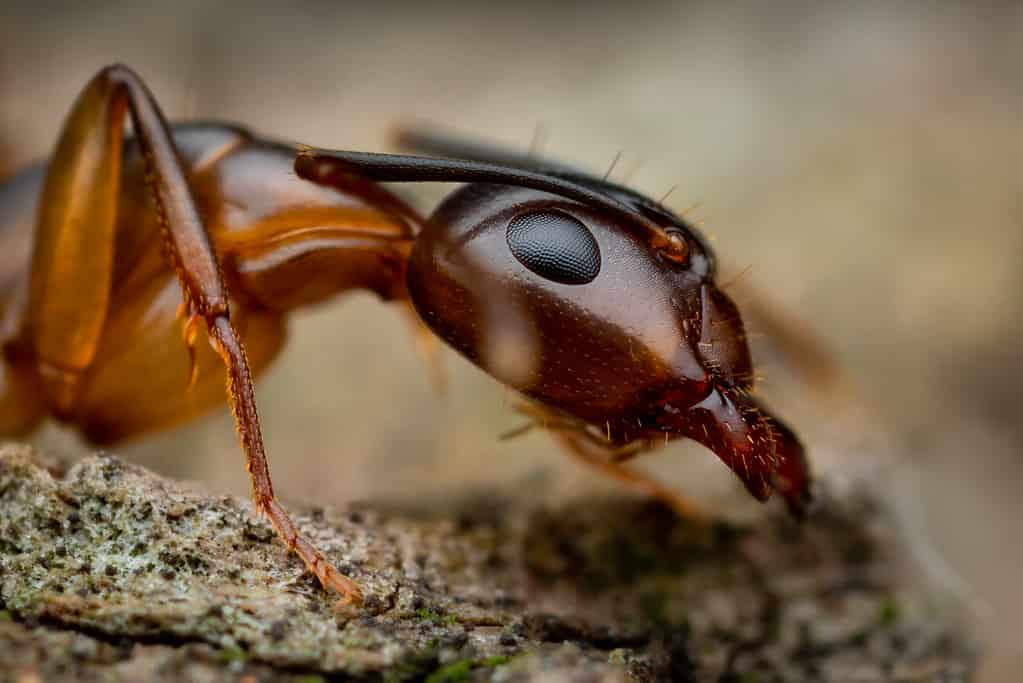
The Argentine ant is able to establish large colonies with multiple queens.
©Javier Chiavone/Shutterstock.com
The Argentine Ant, another invasive species in Montana, forms extensive supercolonies that can dominate local ant communities. These small, light-brown ants are known for their ability to establish large colonies with multiple queens. They are highly adaptable and can thrive in a variety of environments.
5. Thief Ant (Solenopsis molesta)
Thief Ants, also known as grease ants, are tiny ants that are attracted to greasy or oily foods. They are pale yellow to brown and often invade homes in search of food. Their small size allows them to access hard-to-reach areas, making them challenging to control once established.

Thief Ants have wings.
©Vinicius R. Souza/Shutterstock.com
6. Odorous House Ant (Tapinoma sessile)
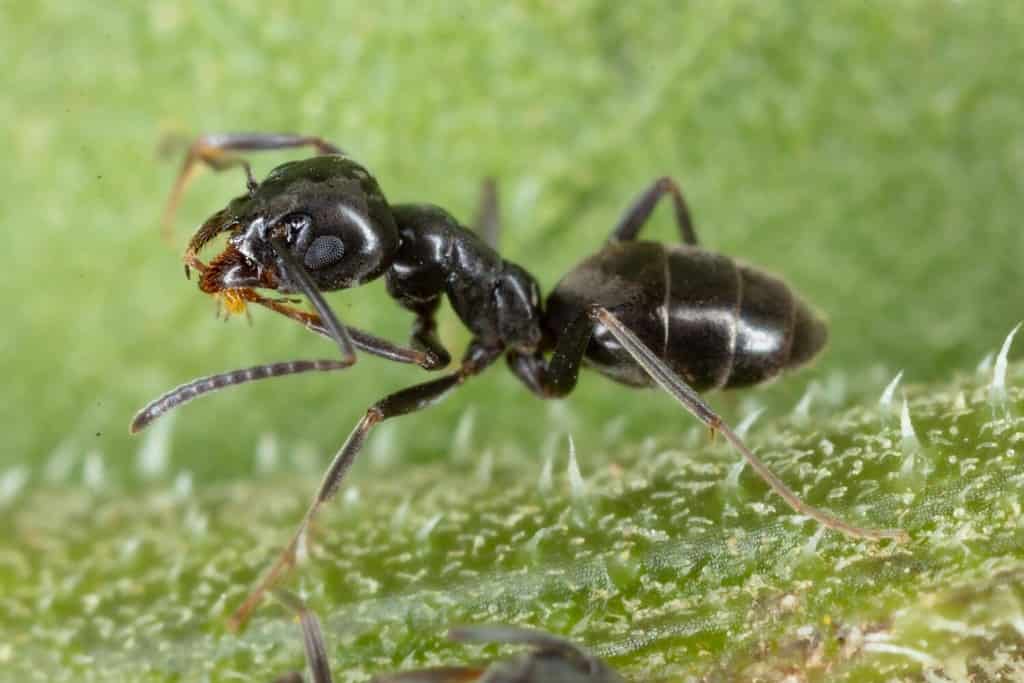
Odorous house ants emit a distinct rotten coconut-like odor.
©Wirestock Creators/Shutterstock.com
As the name suggests, when crushed, Odorous House Ants emit a distinct, rotten coconut-like odor. These small, brown ants form large colonies and are often found indoors. They are attracted to sweet foods and can quickly become a nuisance if left unchecked.
7. Pavement Ant (Tetramorium caespitum)
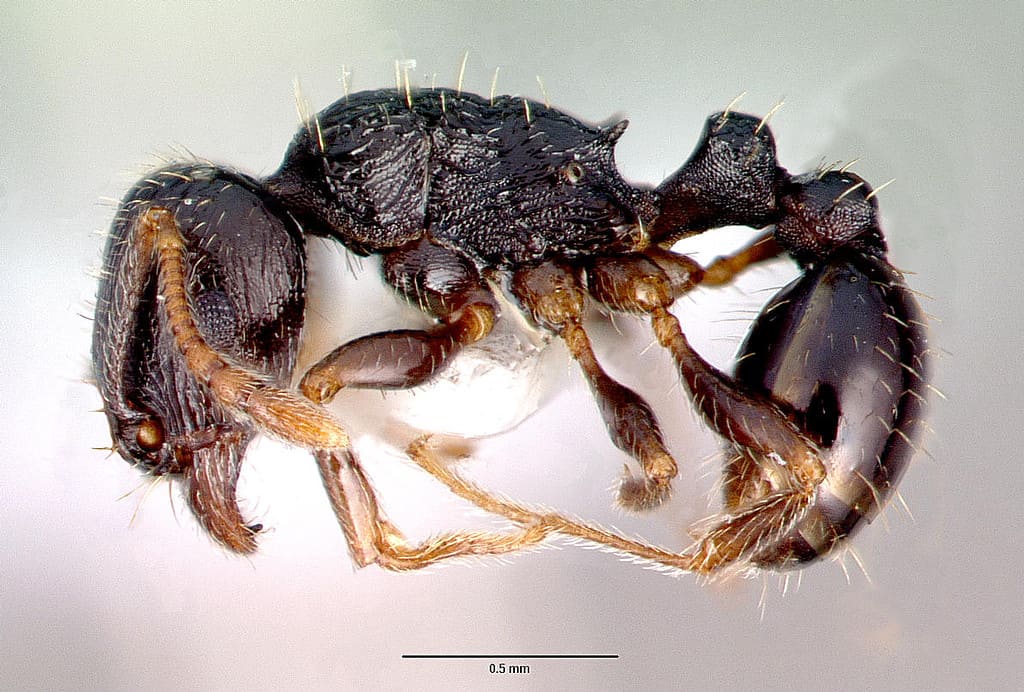
Pavement ants construct small mounds of soil at the entrance of their nests.
©© AntWeb.org / CC BY-SA 3.0 – License
Pavement Ants nest beneath pavement cracks, sidewalks, and driveways. These dark brown to black ants construct small mounds of soil at the entrance of their nests. They are opportunistic feeders and will scavenge on a wide range of food items.
8. Allegheny Mound Ant (Formica exsectoides)
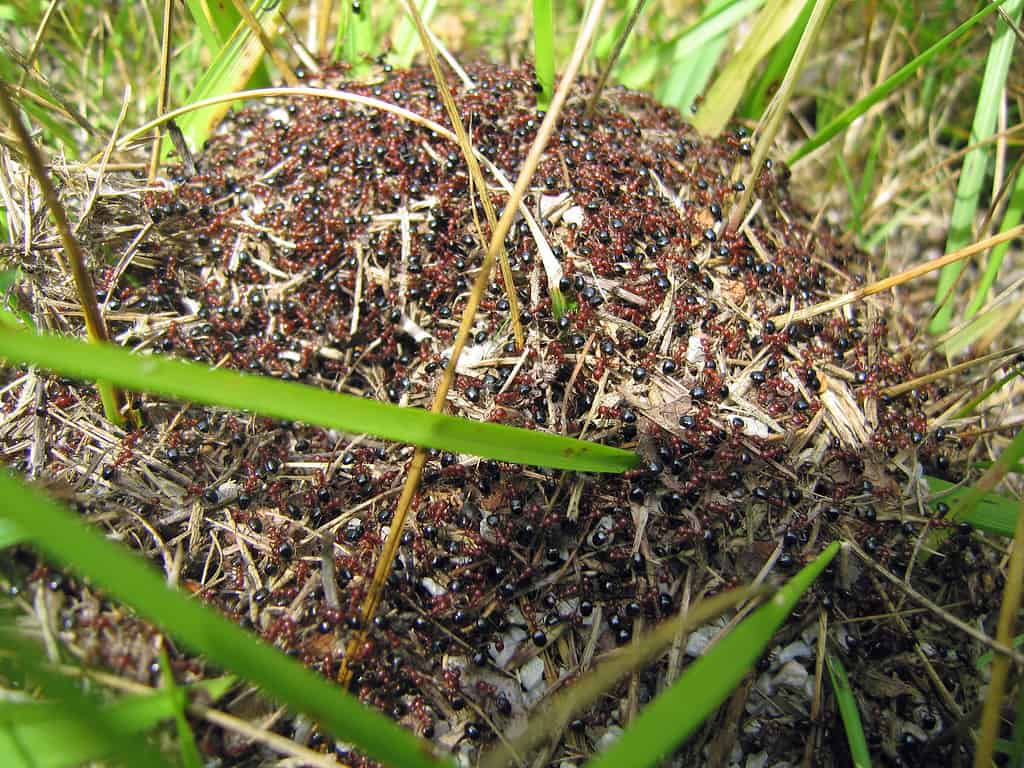
The colonies of Allegheny mound ants are incredibly complex.
©Allegheny Mound Ants, Formica exsectoides – License
Allegheny Mound Ants are known for their large, dome-shaped mounds, which can reach impressive heights. These reddish-brown ants are ecologically important as they aerate the soil and help control other arthropod populations. You can find them in open grasslands and meadows.
9. European Fire Ant (Myrmica rubra)
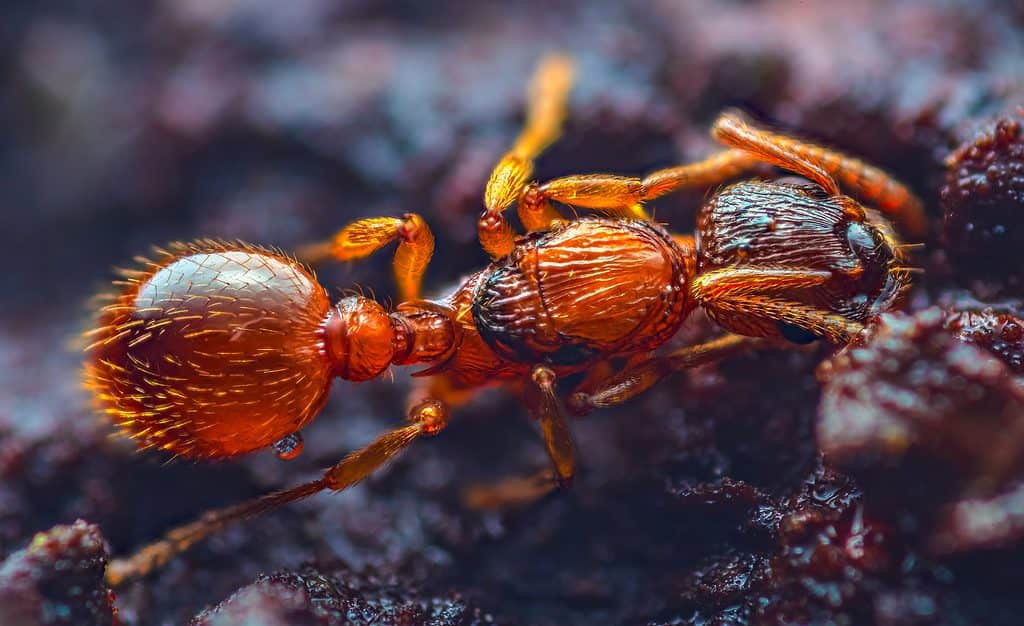
These reddish-brown ants create small, inconspicuous nests in lawns and gardens.
©Lukas Jonaitis/Shutterstock.com
The European Fire Ant, another invasive species, has aggressive behavior and a painful sting. These reddish-brown ants create small, inconspicuous nests in lawns and gardens. They can pose a threat to humans and pets, particularly in areas where populations are dense.
10. Field Ant (Formica spp.)
Field Ants are a diverse group of ants found throughout Montana. They vary in color from black to red; some have aggressive behavior when defending their nests. These ants play a vital role in soil aeration and seed dispersal, contributing to the health of grasslands and forests.
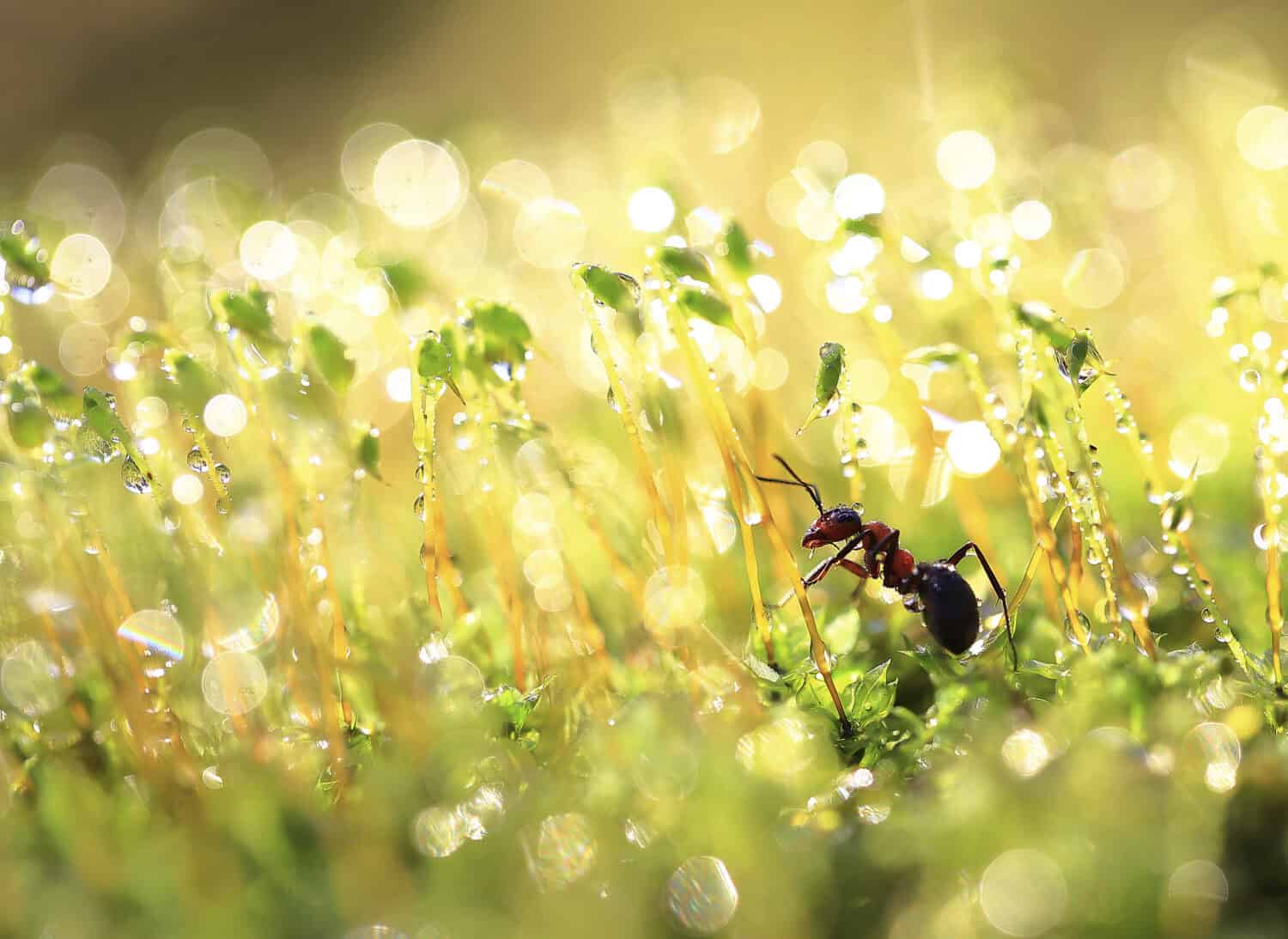
Most ants tend to lay dormant during the winter.
©Victor Shnayder/Shutterstock.com
11. Velvety Tree Ant (Liometopum occidentale)
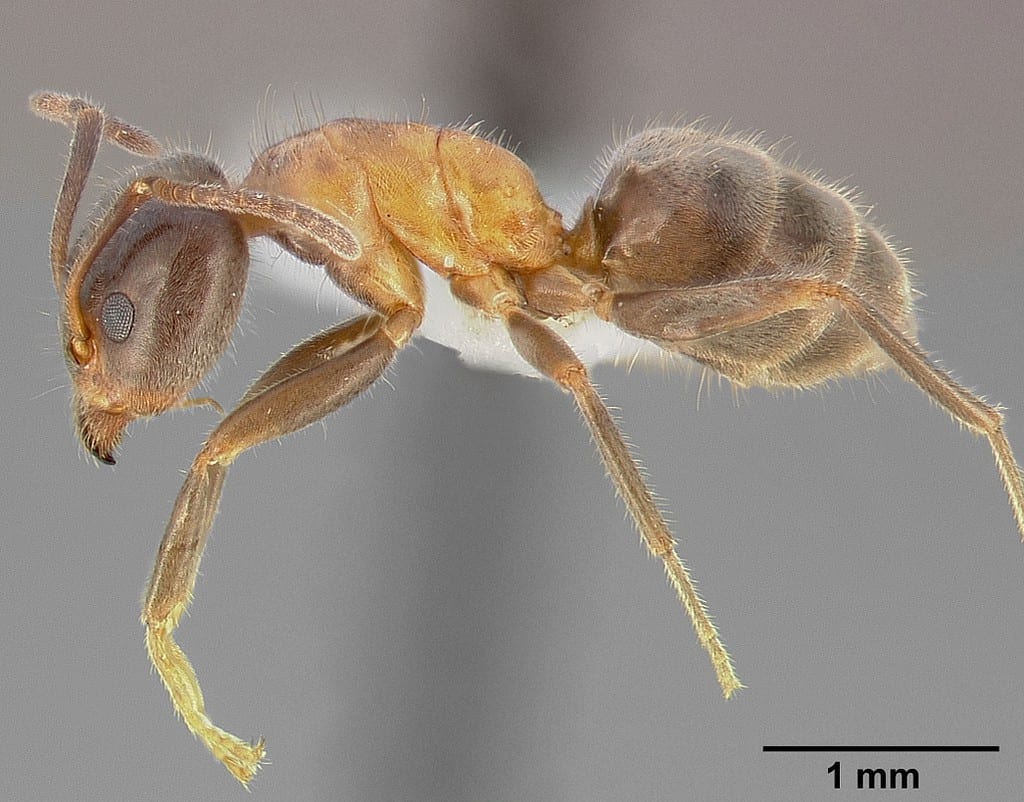
Caution is advised when dealing with velvety tree ants, as they are considered to be dangerous.
©April Nobile / © AntWeb.org / CC BY-SA 3.0 – License
Velvety Tree Ants are larger ants with dark brown or black bodies. They nest in trees and shrubs. These ants have a mutualistic relationship with aphids, protecting them from predators and feeding on the honeydew secreted by the aphids. They are important in maintaining the balance of plant-insect interactions.
12. Western Thatching Ant (Formica obscuripes)
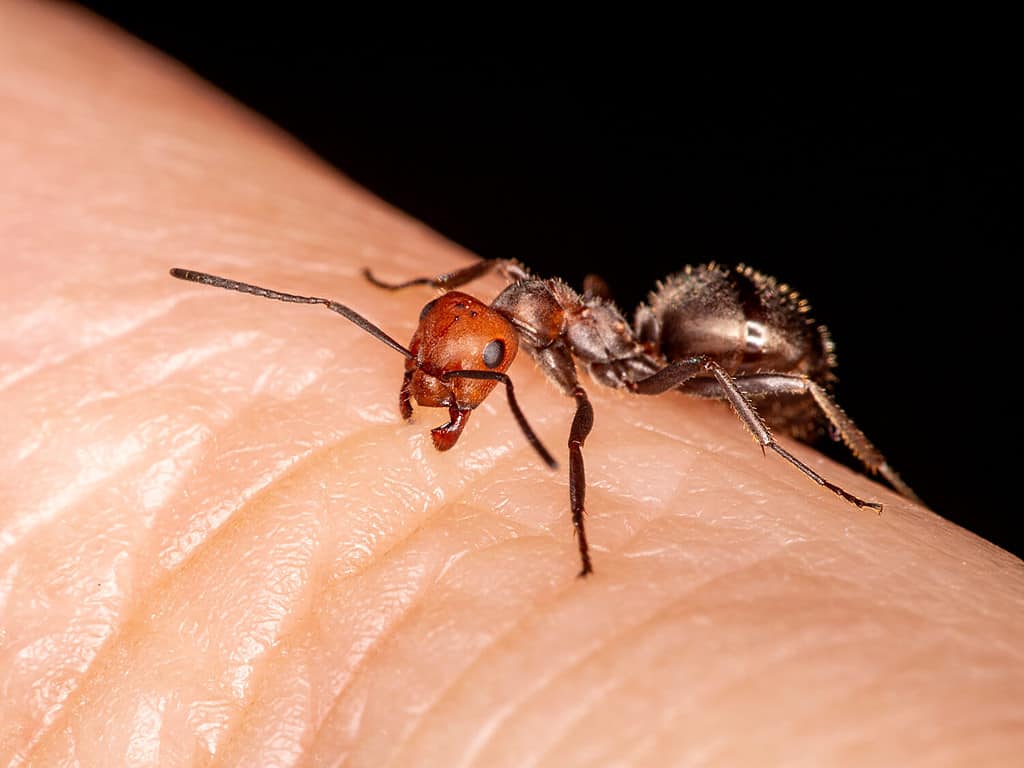
This species dominates various ecosystems, with its large thatched mounds and colossal colonies housing tens or even hundreds of thousands.
©Ernie Cooper/Shutterstock.com
Western Thatching Ants construct intricate thatch nests made from plant materials. Like many other ants, these ants are set to emerge in Montana in the spring and summer months. These ants are reddish-brown and live in grasslands and forested areas. Their thatch nests provide thermal regulation and protection from predators.
13. Pavement Ant (Tetramorium immigrans)
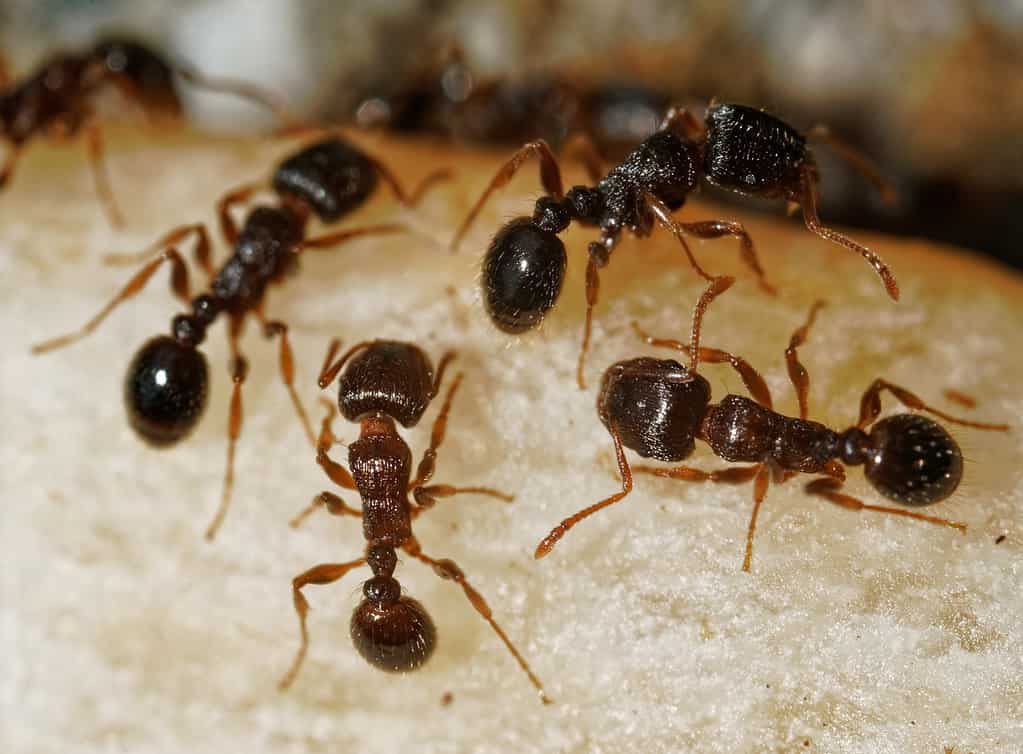
These ants usually appear during summertime and are most active from June to August.
©Bradley Rentz, CC BY-SA 4.0 – License
Pavement Ants are also known as immigrant pavement ants and in certain areas of North America as the sugar ant. These ants are small with a reddish-brown to black coloration. They build nests underground and prefer areas with little to no vegetation. The entrances to their nests are small crater-shaped mounds of sand. These ants are generalist scavengers and feed on a wide variety of food sources.
14. Bicolored Ant (Dorymyrmex bicolor)
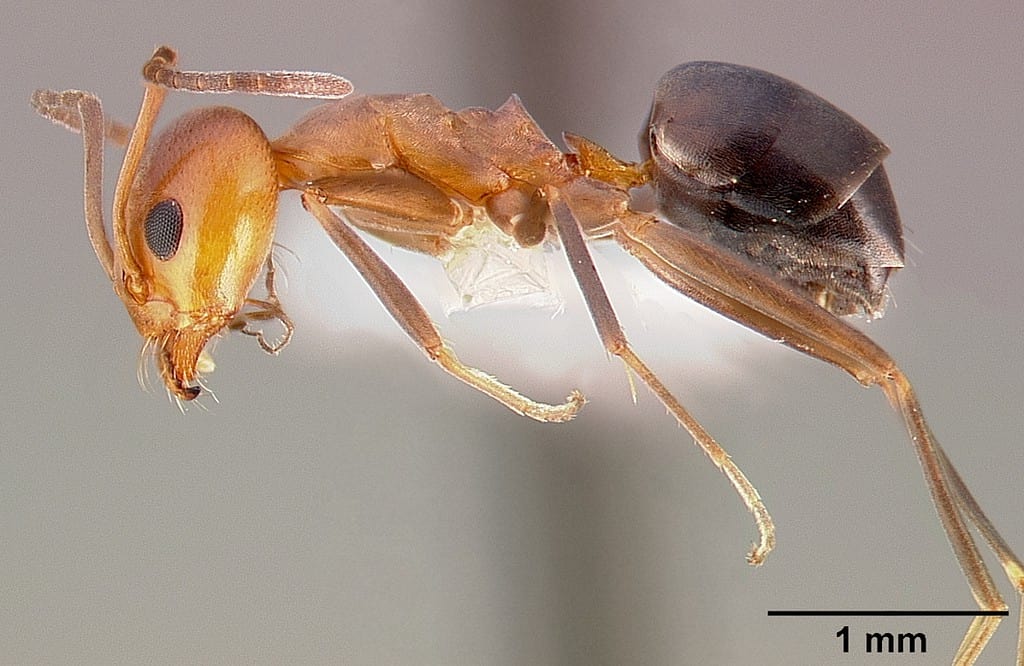
Bicolored Ants are adept at heat regulation and adjusting their mound architecture to control nest temperature.
Bicolored Ants are small ants with a distinctive bicolored appearance, with a combination of black and orange-brown hues. You can spot these ants in sandy or gravelly habitats, such as prairies and dunes. These ants are adept at heat regulation and adjusting their mound architecture to control nest temperature.
15. Acrobat Ant (Crematogaster spp.)
Acrobat Ants get their name from their ability to hold their abdomen over their head when disturbed, resembling a gymnast performing an acrobatic maneuver. These tiny ants are typically brown or black and nest in dead wood or soil. They are omnivorous, feeding on a variety of insects, nectar, and plant sap.

When disturbed, acrobat ants hold their abdomen over their head.
©Pascal Guay/Shutterstock.com
Ant Emergence in Montana
Ants exhibit fascinating behaviors, constructing intricate nests, foraging for food, and engaging in complex social interactions. One crucial aspect of ant life cycles is when ants are set to emerge. This occurs during specific months when environmental conditions are favorable. Let’s explore the emergence patterns of ants in Montana and shed light on the factors influencing their seasonal activity.
Spring Emergence
As winter recedes and temperatures rise, Montana ants emerge from their winter dormancy. The specific timing of spring emergence can vary depending on the region and the ant subspecies. Generally, ants start becoming active in Montana during March, April, and May.
During early spring, when temperatures reach a certain threshold, ant colonies become more active. The increase in temperature stimulates ant workers to resume foraging activities and nest maintenance. The emergence of ants during this period coincides with the availability of food sources, such as plant sap, nectar, and early insect activity.
Summer Activity
Summer is the peak season for ant activity in Montana. The warm temperatures and longer daylight hours create optimal conditions for ant colonies to thrive. Ants become highly active during June, July, and August.
During the summer months, Montana experiences a rich abundance of food resources. Plants are in full bloom, providing a plentiful supply of nectar and pollen. This food availability fuels the foraging efforts of ant colonies as they gather resources to sustain their growing populations. The activity of ants during summer contributes to their vital role in ecosystem processes, such as seed dispersal and soil aeration.
Fall Preparation
As summer transitions into fall, ants in Montana continue their activities, albeit with some variations. During September, October, and November, ants are still visible. However, their behavior begins to shift in preparation for the colder months ahead.
During the fall season, ant colonies focus on food storage and nest preparations for winter. They may exhibit increased foraging activities as they gather resources to sustain their populations during the upcoming period of reduced activity. Some ant species also engage in nuptial flights during this time, where winged reproductive individuals leave the nest to mate and establish new colonies.
Winter Dormancy
Winter in Montana brings cold temperatures and reduced food availability, prompting ants to enter a period of dormancy. This dormant phase typically occurs from December to February when ants retreat to their nests, conserving energy and surviving on stored food reserves.
Ants employ various strategies to endure the harsh winter conditions. Some species hibernate deep within their nests, while others seek shelter in protected microhabitats, such as beneath rocks or in tree bark. This dormant period allows ants to conserve energy and protect their colonies until favorable conditions return in the following spring.
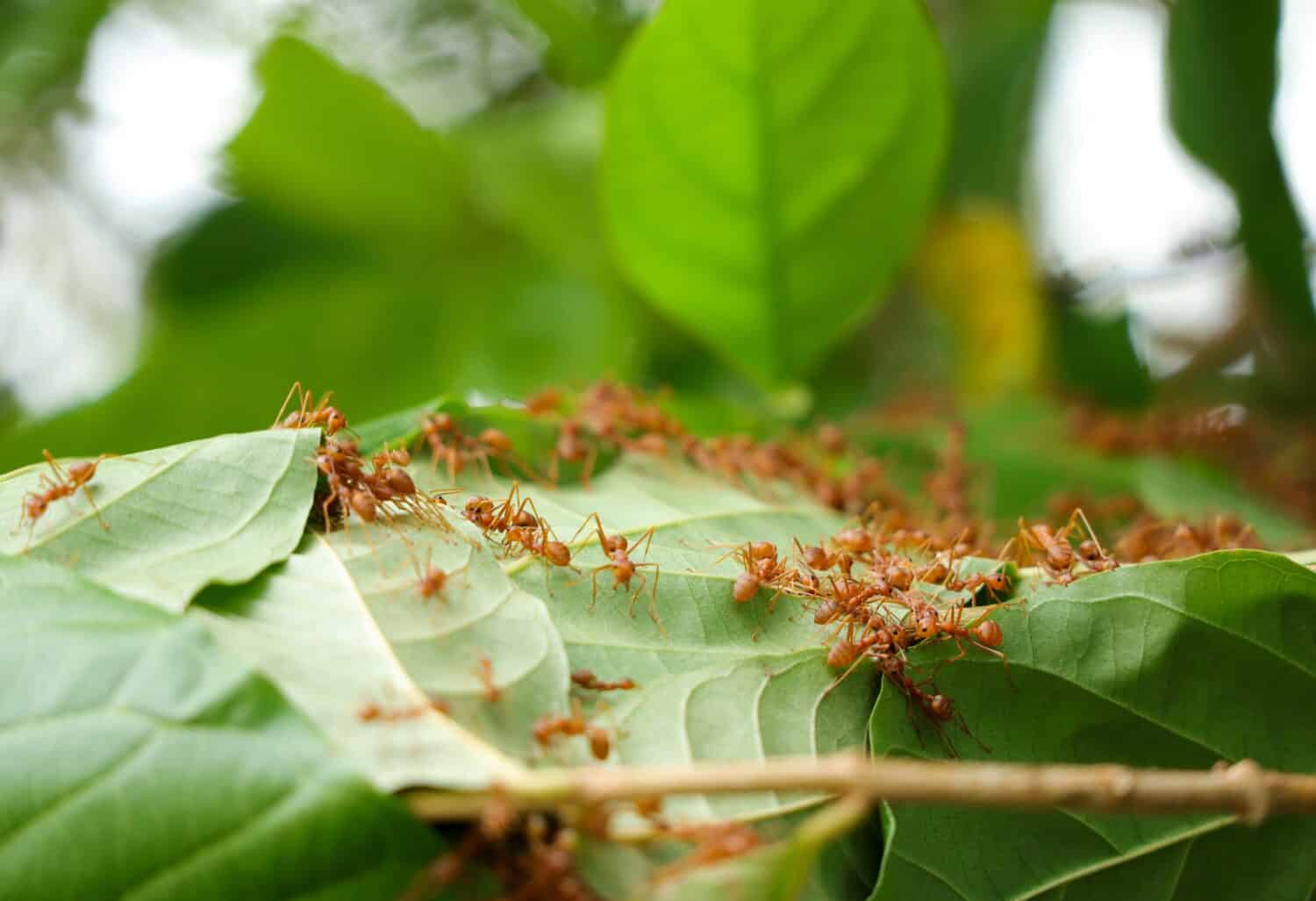
Ants are most active in Montana during the spring and summer months.
©Yuphayao Pooh’s/Shutterstock.com
Factors Influencing Ant Emergence in Montana
A combination of factors, including temperature, precipitation, daylight hours, and the availability of food resources influence when ants are set to emergence in Montana. Understanding these patterns provides valuable insights into the life cycles of ants and their interactions with the environment.
Temperature
Temperature is a primary driver of ant emergence. Most ants require a specific threshold temperature range to become active. As temperatures rise in spring, ants break their winter dormancy and resume their activities.
Precipitation
Adequate moisture levels are crucial for ant survival and activity. Spring rains and snowmelt provide the necessary hydration for ants to initiate foraging and nest-building. Summer rainfall sustains food sources and promotes colony growth and reproduction.
Daylight Hours
When daylight hours lengthen in spring and summer, it signals to ants that it is time to increase their activity. Ants are highly sensitive to changes in photoperiod and adjust their behavior accordingly.
Food Availability
The availability of food resources strongly influences ant emergence. Spring and summer bring an abundance of plant blooms, insect activity, and other food sources. Ant colonies synchronize their emergence with the availability of these resources to maximize their foraging efficiency and colony development.
Species-Specific Factors
Different ant species have varying emergence patterns based on their biological traits and adaptations. Some species may have specific temperature or moisture requirements. In contrast, others may have specialized relationships with certain plants or insects, influencing their emergence timing.
The emergence of ants in Montana follows a seasonal pattern dictated by temperature, precipitation, daylight hours, and food availability. Spring marks the awakening of ant colonies from winter dormancy, with increased foraging and nest-building activities. Summer is the peak season for ant activity, with abundant food resources supporting colony growth. As fall approaches, ants focus on resource accumulation and reproductive activities before entering winter dormancy.
Understanding the emergence patterns of ants provides insights into their life cycles and their interactions with the environment. By studying these patterns, researchers and enthusiasts can gain a deeper appreciation for the complex behaviors and adaptations of ants in Montana.
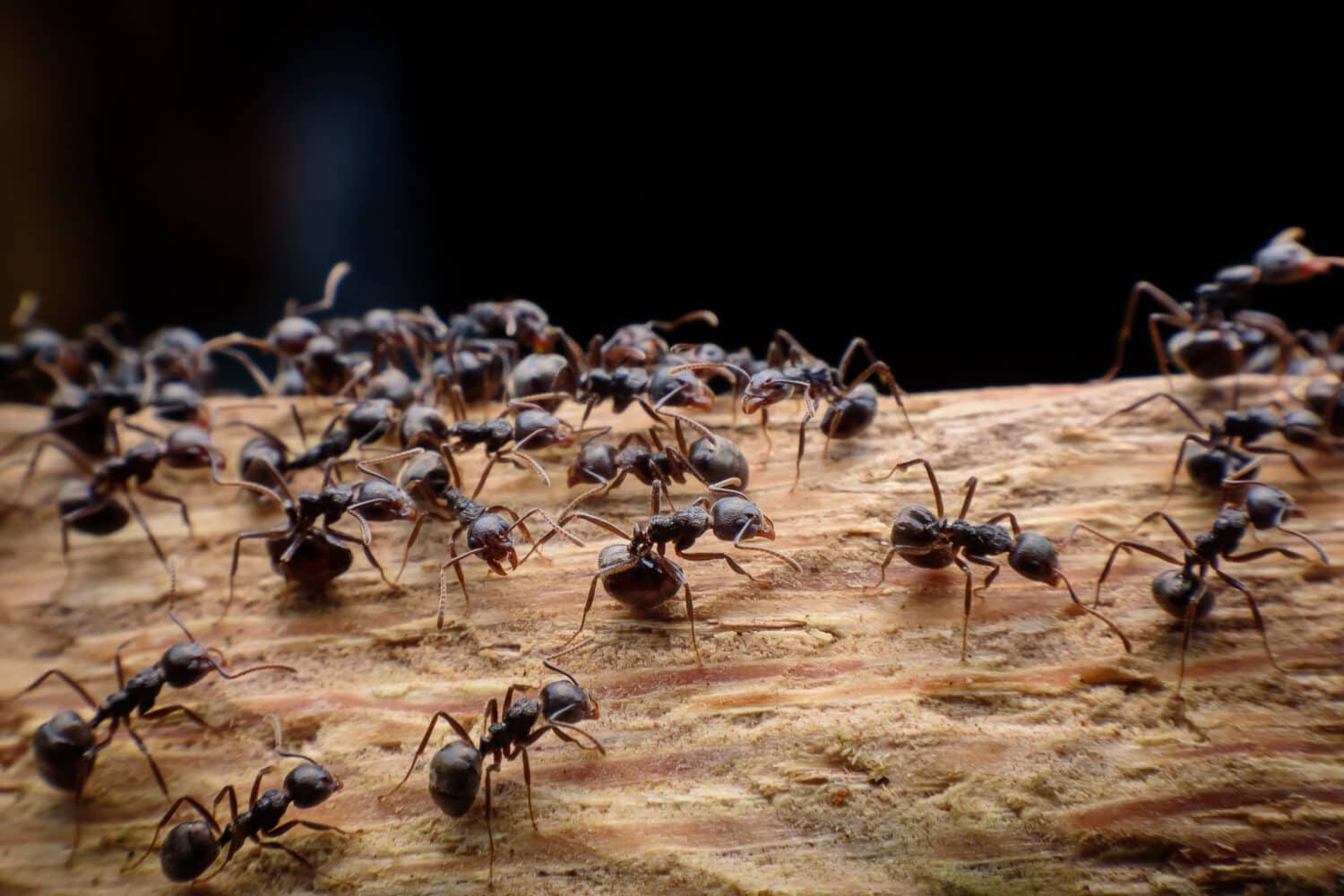
Many factors affect ant activity levels.
©ArtLovePhoto/Shutterstock.com
Other Common Insects That Emerge Alongside Ants in Montana
As spring arrives in Montana, the natural world awakens, and a plethora of insects emerge to take advantage of the favorable conditions. Alongside the ants set to emerge in Montana, numerous other insects make their appearance during this time, contributing to the vibrant ecosystem of the state.
Butterflies
Montana is home to diverse butterfly species that emerge in the spring. Species such as the Western Tiger Swallowtail (Papilio rutulus) and the Mourning Cloak (Nymphalis antiopa) are often among the first to emerge. These colorful insects are essential pollinators, contributing to the reproduction of numerous plant species.
Bees
Spring heralds the emergence of various bee species in Montana. Bumblebees, such as the Western Bumblebee (Bombus occidentalis), and solitary bees, like the Blue Orchard Bee (Osmia lignaria), become active during this time. Bees play a crucial role in pollination, facilitating the reproduction of flowering plants and ensuring biodiversity.
Grasshoppers and Crickets
As spring progresses, the familiar chirping of grasshoppers and crickets fills the air. These insects, such as the Two-striped Grasshopper (Melanoplus bivittatus) and the Spring Field Cricket (Gryllus veletis), emerge from overwintering sites and engage in courtship and mating rituals. Grasshoppers and crickets play important roles in the food chain, serving as a food source for birds and other predators.
Mosquitoes
While they may not be the most welcome of insects, mosquitoes also emerge during the spring in Montana. As temperatures rise and stagnant water accumulates, mosquito populations increase. These insects, such as the Western Treehole Mosquito (Aedes sierrensis), can transmit diseases. However, they also serve as a food source for birds, bats, and other insectivorous animals.
Mayflies
Mayflies have delicate wings and short adult lifespans. You can find them near bodies of water in Montana during the spring. Species like the Western Green Drake (Drunella grandis) hatch in large numbers, providing a vital food source for fish and other aquatic organisms.
Moths
Montana is home to a wide variety of moth species that emerge in the spring. These nocturnal insects, such as the Luna Moth (Actias luna) and the Western Tent Caterpillar Moth (Malacosoma californicum), play important roles in pollination and serve as a food source for birds and bats.
Antlions
Antlions are fascinating insects that inhabit sandy or loose soil habitats in Montana. The larvae of these insects construct cone-shaped pits in which they lie in wait to ambush unsuspecting ants and other small insects. The emergence of antlions in the spring contributes to the predator-prey dynamics in the ecosystem.
True Bugs
True bugs, such as the Western Boxelder Bug (Boisea rubrolineata) and the Big-eyed Bug (Geocoris spp.), emerge in Montana during the spring. These insects have piercing mouthparts and feed on plant sap or other small insects. True bugs play a role in plant health and nutrient cycling.
Spring in Montana not only marks when ants are set to emerge in Montana but also brings forth a diverse range of insects that contribute to the ecological balance and beauty of the state. From graceful butterflies and dragonflies to diligent bees and ladybugs, these insects play vital roles in pollination, pest control, and nutrient cycling. Their emergence during the spring months signals a renewed cycle of life.
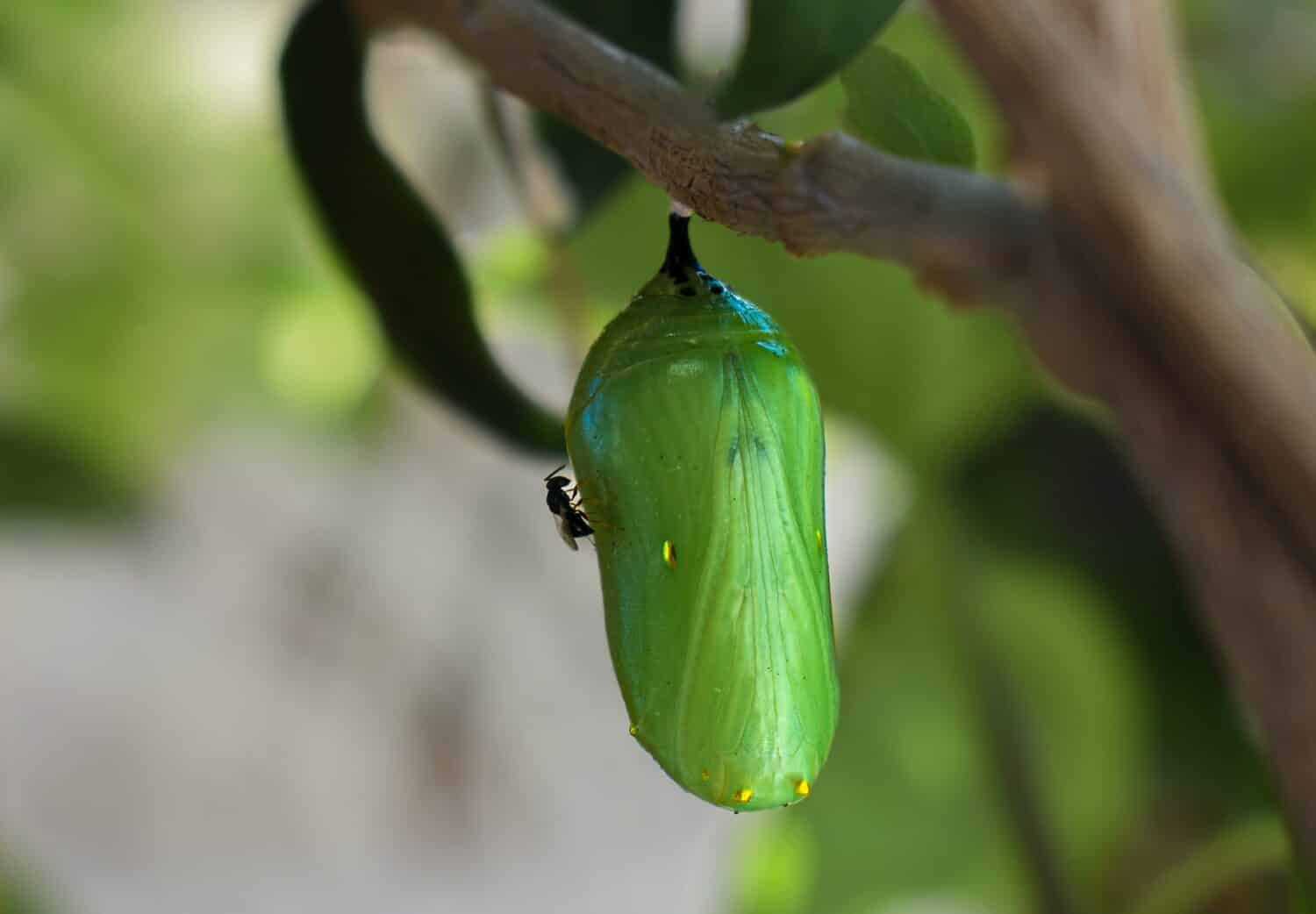
Ants and other insects all contribute to the ecosystem.
©SuJo Studios/Shutterstock.com
Conclusion
Ants in Montana exhibit fascinating emergence patterns, with the Western Harvester Ants and Red Imported Fire Ants being among the first to emerge in the spring. The summer season sees a peak in ant activity. In contrast, fall is characterized by resource accumulation and reproductive activities. As winter approaches, ants enter a period of dormancy to survive the cold months.
Understanding the emergence patterns of ants, specifically when ants are set to emerge in Montana, provides insights into their life cycles and their critical roles in seed dispersal, soil aeration, and nutrient cycling. Montana’s diverse ant species coexist with a variety of other insects that emerge during the same seasons, contributing to the balance and health of ecosystems.
As we explore the ants and insects of Montana, we gain a deeper appreciation for the intricate web of life in which they exist. From the resilience of ants to the diverse roles played by butterflies, bees, and ladybugs, each insect contributes to the vibrancy and interconnectedness of the natural world.
Montana is a beautiful place for entomological enthusiasts and nature lovers, offering a glimpse into the wonders of even the smallest creatures. The ants and insects of Montana remind us of these tiny organisms’ significance and impact on the ecosystems they inhabit.
Summary of the 15 Types of Ants Set to Emerge in Montana This Summer
| Rank | Type of Ant |
|---|---|
| 1 | Western Harvester Ant |
| 2 | Red Imported Fire Ant |
| 3 | Carpenter Ant |
| 4 | Argentine Ant |
| 5 | Thief Ant |
| 6 | Odorous House Ant |
| 7 | Pavement Ant |
| 8 | Allegheny Mound Ant |
| 9 | European Fire Ant |
| 10 | Field Ant |
| 11 | Velvety Tree Ant |
| 12 | Western Thatching Ant |
| 13 | Pyramid Ant |
| 14 | Bicolored Ant |
| 15 | Acrobat Ant |
The photo featured at the top of this post is © Erik Agar/Shutterstock.com
Thank you for reading! Have some feedback for us? Contact the AZ Animals editorial team.





